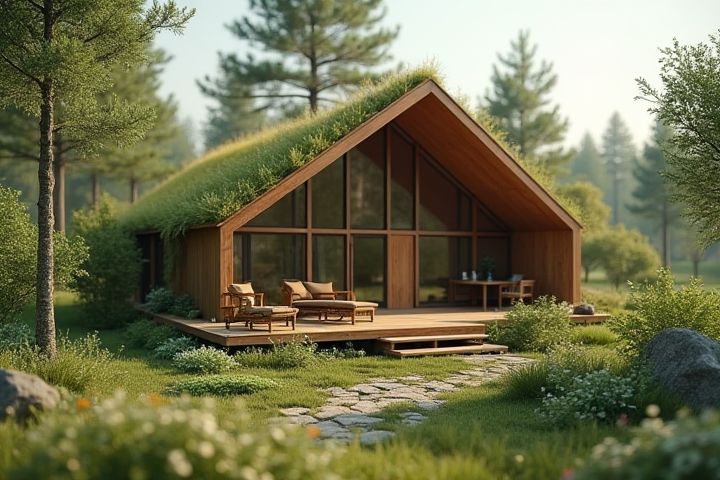
An eco-sustainable house integrates energy-efficient technologies, renewable resources, and environmentally friendly materials to minimize its ecological footprint. Using solar panels, wind turbines, and rainwater harvesting systems can significantly reduce reliance on non-renewable energy sources and lower utility bills. Insulating materials such as recycled denim or sheep's wool enhance energy conservation by maintaining optimal indoor temperatures. Incorporating native landscaping and permaculture principles supports local biodiversity and promotes sustainable practices in gardening. By prioritizing sustainable building practices, your home can contribute to a healthier planet while providing a comfortable living environment.
Can A House Be Eco-Sustainable
Renewable Energy Sources
An eco-sustainable house integrates renewable energy sources, significantly reducing its carbon footprint and energy costs. Solar panels harness sunlight, converting it into electricity, while wind turbines can generate additional power for your home's needs. Incorporating geothermal heating and cooling systems effectively utilizes the earth's stable temperatures for energy efficiency. By focusing on these renewable technologies, you can create a home that aligns with environmental stewardship and sustainable living practices.
Insulation Efficiency
Eco-sustainable homes prioritize insulation efficiency to reduce energy consumption and environmental impact. By utilizing materials such as cellulose, fiberglass, and spray foam, these houses enhance thermal performance and lower heating and cooling costs. Proper insulation not only improves indoor comfort but also minimizes the carbon footprint associated with energy use. You can opt for double-glazed windows and airtight construction techniques to further improve insulation efficiency and achieve a truly sustainable living space.
Sustainable Building Materials
Eco-sustainable homes often utilize sustainable building materials, which can significantly reduce environmental impact. For instance, bamboo, a rapidly renewable resource, can be used for flooring and cabinetry, showcasing durability and a lower carbon footprint. Recycled steel and reclaimed wood are also popular choices, providing strength while minimizing waste. By integrating insulation made from recycled denim or cellulose, you can enhance energy efficiency, leading to lower utility bills and a more comfortable living environment.
Energy-Efficient Appliances
A house can achieve eco-sustainability by incorporating energy-efficient appliances that reduce electricity consumption and lower utility bills. These appliances, such as ENERGY STAR-rated refrigerators, washing machines, and dishwashers, use advanced technology to operate effectively while minimizing energy use. Implementing smart thermostats further enhances energy efficiency by optimizing heating and cooling based on your lifestyle habits. By choosing energy-efficient options, you actively contribute to environmental conservation, reduce your carbon footprint, and promote a sustainable lifestyle.
Water Conservation Systems
Eco-sustainable houses can significantly benefit from effective water conservation systems, incorporating techniques such as rainwater harvesting, greywater recycling, and low-flow fixtures. For instance, implementing a rainwater collection system can capture over 50% of your household water needs, thereby reducing dependence on municipal sources. By installing greywater systems that repurpose water from sinks, showers, and washing machines, you can save approximately 30% on your overall water consumption. These innovative solutions not only lower your water bills but also contribute to environmental sustainability by minimizing waste and preserving precious resources.
Passive Solar Design
A house can certainly achieve eco-sustainability by focusing on Passive Solar Design, which optimizes natural sunlight for heating and lighting. This design strategy employs features like south-facing windows, thermal mass materials, and proper ventilation to regulate indoor temperatures throughout the year. You can enhance energy efficiency by using high-performance insulation, minimizing air leaks, and integrating shading devices to prevent overheating in warmer months. This approach not only reduces reliance on artificial heating and cooling systems but also lowers your carbon footprint and utility bills.
Green Roofs and Walls
A house can achieve eco-sustainability with green roofs and walls, which utilize vegetation to improve energy efficiency and enhance biodiversity. These systems provide natural insulation, reducing heating and cooling costs while absorbing rainwater, effectively managing stormwater runoff. By incorporating native plant species, your green roof or wall can support local wildlife, including pollinators, and contribute to air quality improvements. Additionally, the aesthetic appeal of living architecture can increase property value and promote environmental awareness in your community.
Smart Home Technology
An eco-sustainable house integrates smart home technology to enhance energy efficiency and reduce environmental impact. Home automation systems optimize lighting and climate control, adjusting in real-time to your habits and preferences, thereby minimizing energy waste. Smart appliances contribute by utilizing energy during off-peak hours, while advanced monitoring systems track resource consumption, allowing you to make informed decisions. By prioritizing renewable energy sources, such as solar panels and energy storage systems, a sustainable smart home not only conserves resources but also reduces your carbon footprint.
Eco-Friendly Landscaping
Eco-sustainable houses can greatly benefit from eco-friendly landscaping, which integrates native plants, permaculture principles, and water-efficient irrigation systems. By choosing drought-resistant plants and minimizing lawn areas, you reduce water consumption while promoting biodiversity in your yard. Implementing organic mulch and compost enriches the soil and supports healthy ecosystems, without the need for chemical fertilizers. You can enhance your home's energy efficiency by strategically planting shade trees to lower cooling costs and creating outdoor spaces that encourage wildlife habitats.
Waste Reduction Practices
An eco-sustainable house can significantly reduce waste through effective practices. Implementing a composting system can divert up to 30% of your household waste, transforming organic materials into nutrient-rich soil. By choosing materials with minimal packaging or those made from recycled content, you can reduce landfill contributions and promote a circular economy. Using durable, repairable products also extends their lifespan, further minimizing waste and promoting sustainability in your home.
